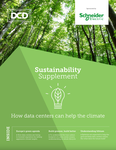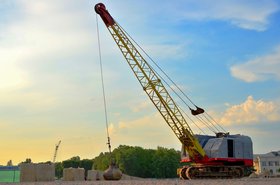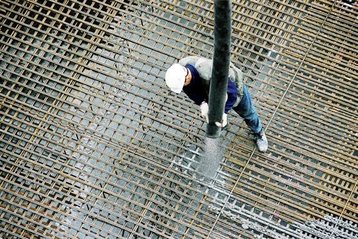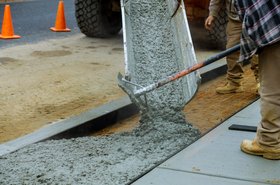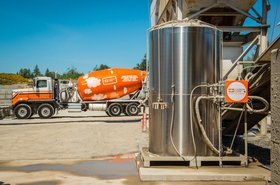There’s no shortage of sustainable activity going in the data center space. Hyperscalers such as Amazon, Microsoft, and Google have made carbon-neutral commitments and have made significant investments in sourcing renewable energy for their facilities. And in 2021 alone, the likes of ChinData, MTN, and IBM have made similar pledges to become carbon neutral before 2040.
However, much of the conversation is still around operational sustainability and ensuring the facilities use as little power as possible, use green energy where they can, and have minimal or even carbon negative impacts on the local area through district heating initiatives and natural cooling.
But is enough thought being given to the environmental impact of the construction phase around data centers and the material impact of the construction materials they use? Data centers use huge amounts of concrete and steel, which are major sources of CO2, and as the sustainability gains from operational efficiencies dry up, firms will have to look to embodied carbon in the construction phase if they are serious about being climate neutral.
“Until now, the modern green building movement has largely focused on reducing operational energy – the energy used to heat, cool, and power buildings – which is easy to see and measure,” says Stacy Smedley, Chair and Executive Director of Building Transparency.
“While this effort has produced many successes, it’s not enough.”
This article appeared in 2021 sustainability supplement. Read it for free today
Embodied carbon the next phase
Embodied carbon is the sum of all the greenhouse gas (GHG) emissions resulting from the mining, harvesting, processing, manufacturing, transportation and installation of building materials, and is a major source of carbon globally.
Cement and steel are the most carbon-intensive construction materials, two materials data centers use in abundance. On average, a ton of cement will produce 1.25 tons of CO2, largely from the roasted limestone and silica. And as a result, buildings are responsible for around 40 percent of annual global greenhouse gas emissions and 40 percent of all raw material
consumption.
Building Transparency says embodied carbon makes up half of a building’s total carbon emissions, but with data centers, the fact they are energy-intensive powered shells changes the equation slightly. The operational carbon impact of a data center can be more than twice the embodied carbon impact, according to Michael Riordan, Managing Director of Linesight UK, and focus has historically been on the operational side more than the embodied carbon aspect.
However, due to their large size and ever-increasing number, it’s not a topic that should be avoided just because there are more savings to be had in operations.
“At some point, most energy is going to come from wind, solar, and other renewable types of sources,” says Rob Ioanna, Principal at Syska Hennessy, “And when that happens, the conversation is starting to turn to embodied carbon because that's really going to be where we're going to have emissions reductions.”
Much of the construction considerations around sustainability still revolve around the impact of operations; how to cool the servers in the most energy-efficient way, what to do with excess heat IT hardware generates, whether the facility uses renewable power, or if there more sustainable options for backup than diesel generators.
These are important considerations, but IT hardware continues to evolve and become more efficient, and energy grids rely more on renewable energy, the sustainability gains and carbon reduction companies are looking to make will be harder to come by through operational efficiencies alone.
“As we start to reduce our operational emissions and the energy grid start to get cleaner, emissions of the materials that we're building with on our construction projects actually become a larger source of emissions,” says Smedley. “For some of these large data center owners that are already purchasing 100 percent green energy for some of their markets and projects, they'll already view themselves as carbon neutral on the energy side, and for those owners, the embodied carbon emissions are really what's left to tackle.”
The fact that data centers are often fairly standardized in their construction also means once low-carbon practices and standards have been established at one facility it should be easy to replicate across future facilities without too much heavy lift.
Slow progress in CO2 reduction
Linesight’s Riordan says that concrete often accounts for as much as 40 percent of a data center's construction, followed by fuel (~25 percent) and then steel – both reinforcement and structural – which can account for 10 percent of a project’s carbon footprint each. He adds that adopting low carbon approaches to new builds can result in 13 percent less carbon during construction, but repurposing a building saves a lot more.
Building a new facility creates eight times as much carbon as repurposing, so upgrading an old building can save 78 percent of the carbon emissions of construction. The Global Cement and Concrete Association has committed to zero emissions concrete by 2050. And while there will be no silver bullet to reach that goal, there are a number of startups and trends in the materials space looking to reduce the carbon impact of this core building material.
CarbonCure reduces the emissions of the concrete industry, by injecting waste CO2 into the mix. It hopes to remove 500 megatons of carbon dioxide annually from the concrete industry by 2030. Compass Data Centers are a CarbonCure customer, with CIO Nancy Novak saying the company estimates an average of 1,800 tons of CO2 per campus will be saved as a result. Amazon and Microsoft have also invested in the company. Novak tells DCD that Compass are also looking into other embodied carbon technologies for aggregate.
In terms of the spoil or ground that is raised during a data center’s construction, Novak says Compass will process it so it can be used for structural fill whenever possible, and will check if other projects in the vicinity of the site need clean fill before hauling it. If the spoils are unsuitable for structure, Compass will often make berms and natural landscapes to enhance security and add to the amount of green space on a campus. In 2018, AWS used 100,000 tons of spoil from its Stockholm data center to raise the altitude of the Vilsta ski resort by ten meters.
She adds that more offsite construction is key to reducing impact. “We need to be thinking in the mindset of manufacturing, where transportation and utilization of local materials as well as sustainable materials, is paramount.”
“Everything from advanced work packaging, prefabricated components and fully modularized rooms and buildings, needs to be more widely adopted and normalized in the construction industry.”
A number of architecture and design firms tell DCD that broadly we are still very early in the conversation around embodied carbon, but progress is being made slowly as awareness of the issues increases. There are clients that engage their sustainability teams really early on in the design process, says Todd Boucher, Principal & Founder, Leading Edge Design Group (LEDG), “and in other cases where the construction is more driven from that mission-critical sort of viewpoint, we find ourselves trying to weave in the sustainability discussion around how we could help improve the net environmental impact without an impact on reliability. But I don't think the conversation has extended far beyond efficiency into embedded carbon and sustainability. ”
There are increasing examples of companies looking to green materials; Digital Reality announced it was using ‘sustainable materials, including recycled concrete and steel’ in its 430,000 square foot (40,000 sqm), four-story expansion of its Santa Clara campus in California.
“Transportation from manufacturing yards to sites is a massive part of the carbon footprint on construction,” says Ashley Buckland, managing director at JB Associates. “Big companies are now looking at transportation and where materials or parts are coming from, and if they can source local materials or workers they will.”
“We’ve seen materials, such as carpets made from recycled bottles becoming more prevalent in recent years,” says Adrian Brewin, co-founder of Reid Brewin Architects, “and clients are more conscious of the origins of materials such as tiling – opting for local suppliers rather than exotic ones.”
There’s also a regular stream of news about eco-bricks being made from novel recycled or organic materials. Most recently, bricks made from mushrooms and sawdust were shown in London, but there are others made of everything from construction and demolition waste to loofahs or reused water bottles. However, no one DCD spoke to knew if some of these innovations were ready for prime time.
“Increasingly novel, innovative, recycled, and organic materials are likely to be used in different aspects of large-scale construction within the next [10-20] years,” says Brewin, “but the regulatory systems that are required to approve the industrial processes needed to produce such solutions, to the sheer volume we would need, will likely take tens of years to implement.”
And just because data centers could be built, or even 3D printed, from such novel materials doesn’t mean many firms will be willing to take the financial or resiliency risks to use them in construction.
“Owners adopt low-risk mindsets,” says LEDG’s Boucher. “If materials may not be proven enough yet, it would be a challenge to implement them in a data center environment that has any form of mission criticality.”
This low risk mindset also means resilience and redundancy are higher on the list of priorities than sustainability. However, as companies move more towards fewer centralized facilities and more Edge data centers and availability zones, the environmental impact per site lowers. This creates more opportunity to introduce greener thinking into smaller sites.
“We are an industry that has rightfully been completely focused on availability and reliability. And that has governed most decision-making. But with the utilization of hybrid cloud models and the geographic diversification of data centers, we are moving away from the idea that a data center has to be this huge monolithic Tier IV facility,” he says.
“And because of that softening of the perspective, we now can integrate different elements about energy efficiency and carbon neutrality into the conversation that are not solely focused on reliability, even if that still always has to be the number one part of the conversation.”
Obviously utilizing existing buildings where possible is more sustainable than building new. Serverfarm calculates that reused existing buildings can deliver embodied carbon savings of 88 percent compared with the material carbon cost of new projects.
Design firm HKS analyzed Serverfarm’s 25MW, six-story 150,000 square feet (14,000 sq m) Chicago facility, and found that the carbon cost of building an equivalent building would create over 9,000 tons of carbon emissions, compared to 1,000 tons for building reuse and expansion. Almost all of that saving would come through the reduction in concrete.
Data and benchmarks are needed for sustainable construction
While there are standards & certifications around sustainable buildings – LEED is probably the most well-known – they often focus on the entirety of a building’s lifecycle. Measuring and tracking embodied carbon and the environmental impact of construction and building materials can be difficult, and so creating effective benchmarks from which to measure yourself and others against, and start to make a change, hasn’t historically been easy for companies.
“Embodied carbon is inherently more difficult to measure and track,” says Linesight’s Riordan. “Data is undoubtedly fundamental in quantifying, understanding and reducing the environmental impact within the construction space. What gets measured gets managed.”
LEDG’s Boucher says that when we have a more standardized commonality of language and data, it might be then possible to create something akin to a PUE against which firms might be able to quantify and benchmark their embodied carbon impact against.
There are a number of projects and lifecycle tools looking at how to better measure, understand, and reduce the embodied carbon of construction projects. The EU-funded BAMB project is working on Materials Passports that can help organizations understand the provenance of materials and become more comfortable choosing recycled materials.
Another project is the Embodied Carbon in Construction Calculator (EC3) from Building Transparency. EC3 takes the Environmental Product Declarations (EPDs) – which are third party verified disclosures that detail information around carbon impact, including kilogram of carbon per unit. EC3 takes disclosed EPDs and collates them in a free and open source tool in which users can input their own materials-use during a planned construction project.
It then creates what is essentially a bill of materials and cost estimate in terms of carbon impact per item, allowing users to easily see the environmental impact of their material choices, but also see if there are more sustainable alternatives available.
The hope is not only that firms involved in choosing and procuring materials will opt for greener choices, but that the firms supplying materials will be forced to make all their products greener as a result of losing business.
“Having these owners start to ask for lower-carbon products means the manufacturers start to create lower-carbon products, which then the whole industry benefits from.”
Smedley says one of the goals of EC3 is to make a tool that is easy to use and allow it to be integrated easily into existing processes without heavy lift and that people who aren’t experts in building lifecycles or carbon footprints can quickly use and understand. Early benchmarks from the Carbon Leadership Forum have been released for companies to rate themselves against, and Smedley says companies are already seeing a 30 percent carbon reduction against that high benchmark through using the EC3 tool.
“It helps specifiers start to develop designs limits or benchmarks, from a carbon perspective, and these specifications then get into the bid documents.”
Microsoft was an early pilot partner of the tool, and the company has been using it in its Washington campus remodel as well as its data centers in order to choose lower carbon building materials.
As well as Microsoft, Turner Construction, and Mercury - US and European construction firms with large data center practices - are both pilot partners for the EC3 program. Smedley says it's important that data center firms, especially the hyperscalers, take an interest in reducing their embodied carbon footprint due to the sheer number of facilities they run, both data center and otherwise. Likewise, while enterprise data centers may be smaller in number and size than hyperscalers and colo providers, those companies often have large commercial real estate footprints they can transfer sustainable thinking to and from and likely can impact their construction supply chains.
“In the data center space, a lot of the players are very large companies that have a ton of other types of projects they're building where they can really kind of spur the market and benefit all of their building types by getting to these lower-carbon materials. It's the big players that lead and make it easier for the smaller ones to see they can implement it without much risk or cost.”
The next step, Smedley says, will be looking at mechanical systems, and the carbon impact of materials such as generators with the hope of reducing the emissions from their manufacture.
Carrot and the stick: money talks
While the hyperscalers and largest companies are already committing to carbon-neutral pledges, financial incentives – whether carrot or stick – from government and investors might be required to get smaller firms and those more focused on returns to come on board.
“Ultimately, I believe the only driver is a financial one,” says Brewin of Reid Brewin Architects. "Consideration and effort to reduce the carbon impact of data center construction occurs within the limits of local regulations and occasional certification requirements. Anything more is for political gain or extremely limited, and the only way to encourage sustainable thinking is to make regulatory changes.”
“People don’t like change, and unless they can see a clear business payback for [sustainability] then they don't sign up to it,” says Ashley Buckland, managing director, JB Associates, “There are not enough incentives there.”
In terms of sticks, there are numerous carbon cap regulations coming out of the EU, and New York City also has new carbon cap regulations on the books.
At the same time, investors BlackRock are beginning to require carbon reporting from the firms it invests in.
“There's a big ESG [environmental, social, and corporate governance] push in investment money and there's a lot of laws that are coming out that are putting carbon caps on what you can emit,” says Rob Ioanna, principal at Syska Hennessy. “Those two trends of money putting pressure on companies coupled with government incentives or pushes combining together will probably do some good.”
Meanwhile, Building Transparency’s Smedley says the financial incentive carrot is already there, as less carbon-intensive materials are often cheaper because they have lower manufacturing and processing costs. She also advises firms to get ahead of the game and get up to speed before it becomes a regulatory requirement.
“This is coming as policy. It might not be tomorrow but it might be three years from now. You might as well get your feet wet and just understand what that means before it is potentially a mandatory thing.”
“Every step that we can take, however incremental, is important,” says LEDG’s Boucher. “If, as an industry, we're ignoring the impacts of that the construction piece, then I think that we're really doing a disservice in our commitment towards sustainability.”
Education and transparency are key
Everyone DCD spoke to said one of the most important things any firm in the data center industry can do to encourage more sustainable thinking in the construction phase is to educate and engage with stakeholders on the topic.
Design, engineering, construction, procurement, and sustainability teams should all be asking each other how to make these facilities greener; are there more sustainable materials options, is there scope to use recycled material, is everything being sourced locally where it makes sense, is everything as standardized and modular as it can be? Asking these questions will at least start conversations and may surface more sustainable options. At the same time, firms need to be open in order to share what they’ve learned.
“Hyperscaler type companies have brought transparency into the market around the types of designs that they use in like the open compute project,” says LEDG’s Boucher. Those have been really transformative for the industry, not only in providing reference points for design but demonstrating the importance of collaboration and transparency. Continuing to cultivate that type of transparency in our industry will be important to encourage sustainability.”
“Every company has a responsibility,” adds Buckland of JB Associates. “Anyone working in the data center world needs to be sending the message out how they're trying to reduce their carbon footprint. They should share those initiatives ideas, it’s not something that any company should keep as their little black book.”

